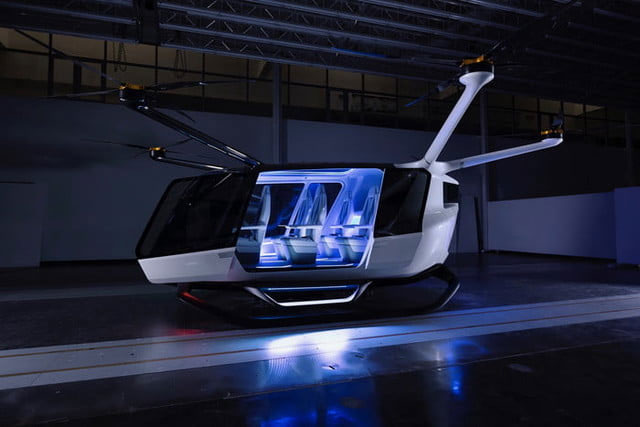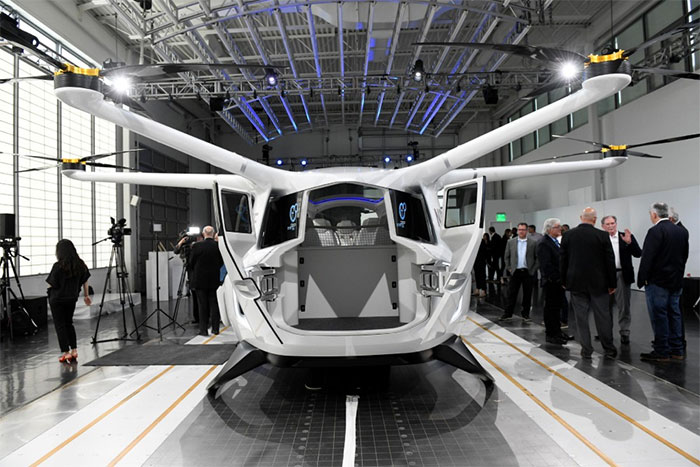The world's first flying taxi uses hydrogen gas
This vehicle has 5 seats, operates with 6 propellers, has the same design as the remote control aircraft.
A model of a flying taxi named Skai , developed by Alakai Technology, was launched at a technology event in Los Angeles, California, USA.
This vehicle has 5 seats, operates with 6 propellers, has the same design as the remote control aircraft. It uses completely hydrogen gas, environmentally friendly fuel.

The prototype of a flying taxi is called Skai, from Alakai Technology Company.
According to Dr. Bruce Holmes, Engineer of Alakai Technology Company, hydrogen gas is the cleanest form of energy available on the planet. Many competitors' designs use batteries, but Alakai believes it can achieve lower environmental impact and better performance from fuel cells.
Fuel cells have a much higher energy density than batteries, he said, meaning they can store more energy in a given volume. This allows weight reduction without sacrificing the scope of operation. Skai's fuel cells are also 99% recyclable, do not use rare earth metals in lithium-ion batteries and have a lifespan that lasts decades. Fueling is also faster than charging, less than 10 minutes.

Skai flying taxi is capable of carrying 4-5 passengers, depending on the driver or unmanned version.
'Hydrogen gas is the cleanest fuel. The only waste that it emits into the environment is water, drinkable, if we make use of it ' - Dr Bruce Holmes, Alakai Technology Company Engineer shared with AFP correspondent.
According to Dr. Bruce Holmes, Alakai will take hydrogen from renewable sources, such as wind, solar and hydropower. Instead of building a network of permanent refueling stations, Alakai plans to refuel its Skai vehicles from trucks, similar to how aircrafts are fueled on runways at airports. . That eliminates a major infrastructure headache, which is now upsetting fuel-cell vehicle manufacturers on the ground.

Alakai currently has four main uses planned for Skai.
A passenger version of Skai Cab will be used as a flying taxi, similar to what Uber and many other companies have proposed.
Skai Cargo model will be used as a dedicated flying vehicle.
The Skai Med version will target first responders, while Skai Craft will be designed to be used as personal transport, through sales to individual owners or through services. share.
Steve Hanvey, CEO of Alakai Technology Company said: 'Skai will provide mobility when moving to customers. This is a clean vehicle, using hydrogen gas as fuel. Very little noise, thanks to special engine design. Skai can carry 4-5 passengers, depending on whether it is self-driving or accompanied by pilots'.
According to Alakai, this flying taxi is also equipped with an umbrella. Skai needs to complete the certification of the FAA, before it can go into production.

The Skai flying taxi model can continue to fly, even if a propeller is lost and an emergency landing can be performed after losing two propellers.
This taxi is considered an ideal means of transportation in the future, in cities where traffic jams often occur and high levels of air pollution.
Alakai Company plans to officially launch the product in 2021 and plans to produce 10,000 units per year.
Earlier, technology companies around the world were also racing to build eco-friendly taxi types. After the successful test of Lithium electric taxi in Germany, Alakai Company introduced the world's first hydrogen-powered taxi.
- The world's first flying taxi system will appear in Israel
- Close-up of unmanned "Flying Taxi" by Google co-founder
- Test a vertical takeoff taxi taxi in Singapore
- Taxi fly passengers on the Seine
- Airbus launched a self-driving taxi with the ability to transform
- Close-up of unmanned
- Close up of Uber's first passenger taxi interior
- The world's first flying taxi system will appear in Israel
- Germans test flying taxis
- The taxi company wants to bring the service to the sky.
- World's first flying taxi in Dubai
- Uber launches taxi service for the next three years
- Airbus will test self-driving taxi at the end of the year
- German flight taxi successfully flew the first flight
 The US company is about to build a supersonic passenger plane of 6,000km / h
The US company is about to build a supersonic passenger plane of 6,000km / h Japan develops avatar robot as in fiction film
Japan develops avatar robot as in fiction film Australia tested the world's first mango picking robot
Australia tested the world's first mango picking robot America develops technology to separate water from animal waste
America develops technology to separate water from animal waste